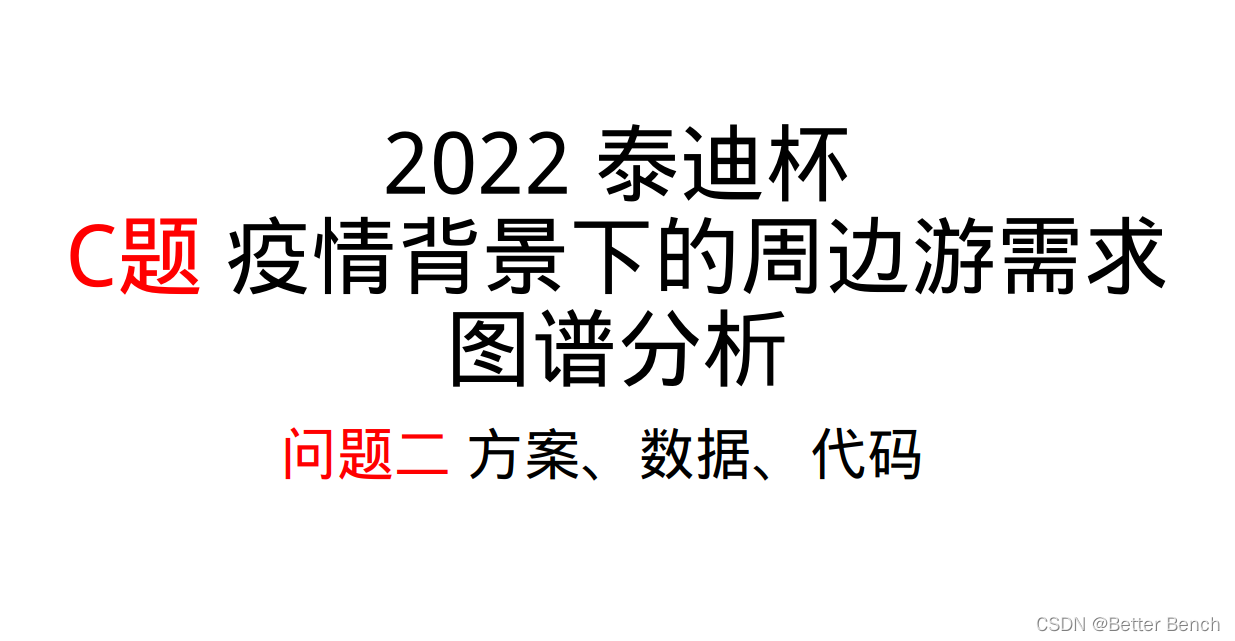
目录
相关链接
(1)问题一方案及实现博客介绍
(2)问题二方案及实现博客介绍
(3)问题三方案及实现博客介绍
代码下载
https://github.com/BetterBench/BetterBench-Shop
1 问题二题目
完整的题目,请看第一篇文章
【第十届“泰迪杯”数据挖掘挑战赛】C题:疫情背景下的周边游需求图谱分析 问题一方案及Python实现
问题二:周边游产品热度分析
从附件提供的 OTA、UGC 数据中提取包括景区、酒店、网红景点、民宿、特色餐饮、乡村旅游、文创等旅游产品的实例和其他有用信息,将提取出的旅游产品和所依托的语料以的形式保存为文件“result2-1.csv”。建立旅游产品的多维度热度评价模型,对提取出的旅游产品按年度进行热度分析,并排名。将结果以表 3 的形式保存为文件“result2- 2.csv”。
2 思路方案
思路:本人从两个维度去计算产品热度,第一个是产品名称的词频,第二个是情感得分。
提取产品名称,是通过Textrank算法中文版提取关键词词组。通过cnsenti包计算情感,正向1,负向-1,中性0。通过权重相加得到总得热度得分。
还可以改进的,需要从其他维度去计算得分,并按一定权重相加。
4 Python实现
from tqdm import tqdm
import pandas as pd
tqdm.pandas()
Hotel_reviews1 = pd.read_excel(
'./data/2018-2019茂名(含自媒体).xlsx', sheet_name=0) # 酒店评论
Scenic_reviews1 = pd.read_excel(
'./data/2018-2019茂名(含自媒体).xlsx', sheet_name=1) # 景区评论
Travel_tips1 = pd.read_excel(
'./data/2018-2019茂名(含自媒体).xlsx', sheet_name=2) # 游记攻略
Dining_reviews1 = pd.read_excel(
'./data/2018-2019茂名(含自媒体).xlsx', sheet_name=3) # 餐饮评论
Wechat_article1 = pd.read_excel(
'./data/2018-2019茂名(含自媒体).xlsx', sheet_name=4) # 微信公众号文章
Hotel_reviews2 = pd.read_excel(
'./data/2020-2021茂名(含自媒体).xlsx', sheet_name=0) # 酒店评论
Scenic_reviews2 = pd.read_excel(
'./data/2020-2021茂名(含自媒体).xlsx', sheet_name=1) # 景区评论
Travel_tips2 = pd.read_excel(
'./data/2020-2021茂名(含自媒体).xlsx', sheet_name=2) # 游记攻略
Dining_reviews2 = pd.read_excel(
'./data/2020-2021茂名(含自媒体).xlsx', sheet_name=3) # 餐饮评论
Wechat_article2 = pd.read_excel(
'./data/2020-2021茂名(含自媒体).xlsx', sheet_name=4) # 微信公众号文章
Hotel_reviews = pd.concat([Hotel_reviews1, Hotel_reviews2],axis=0) # 酒店评论
Scenic_reviews = pd.concat([Scenic_reviews1, Scenic_reviews2], axis=0) # 景区评论
Travel_tips = pd.concat([Travel_tips1, Travel_tips2], axis=0) # 游记攻略
Dining_reviews = pd.concat([Dining_reviews1, Dining_reviews2], axis=0) # 餐饮评论
Wechat_article = pd.concat([Wechat_article1, Wechat_article2], axis=0) # 微信公众号文章
'''
旅游产品,亦称旅游服务产品。是指由实物和服务构成。包括旅行商集合景点、交通、食宿、娱乐等设施设备、
项目及相应服务出售给旅游者的旅游线路类产品,旅游景区、旅游饭店等单个企业提供给旅游者的活动项目类产品
'''
4.1 提取旅游产品
4.1.1 数据准备
由于酒店评论、景区评论和餐饮评论,直接给出了旅游产品,直接汇总就可以。但微信公众号和游记攻略没有特定的旅游产品,需要建立模型,提取出旅游产品的名称
Scenic_reviews.head(10)

def addstr(s):
return '景区评论-'+str(s)
Scenic_reviews['语料ID'] = Scenic_reviews['景区评论ID'].progress_apply(addstr)
Scenic_reviews['文本'] = Scenic_reviews['评论内容']
Scenic_reviews['产品名称'] = Scenic_reviews['景区名称']
Scenic_reviews['年份'] = pd.to_datetime(Scenic_reviews['评论日期']).dt.year
Hotel_reviews.head(10)

def addstr(s):
return '酒店评论-'+str(s)
Hotel_reviews['语料ID'] = Hotel_reviews['酒店评论ID'].progress_apply(addstr)
Hotel_reviews['文本'] = Hotel_reviews['评论内容']
Hotel_reviews['产品名称'] = Hotel_reviews['酒店名称']
Hotel_reviews['年份'] = pd.to_datetime(Hotel_reviews['评论日期']).dt.year
Dining_reviews.head(10)

def addstr(s):
return '餐饮评论-'+str(s)
Dining_reviews['语料ID'] = Dining_reviews['餐饮评论ID'].progress_apply(addstr)
Dining_reviews['文本'] = Dining_reviews['评论内容'] + '\\n'+Dining_reviews['标题']
Dining_reviews['产品名称'] = Dining_reviews['餐饮名称']
Dining_reviews['年份'] = pd.to_datetime(Dining_reviews['评论日期']).dt.year
4.1.2 单独提取公众号和游记攻略的旅游产品
# 采用Textrank提取关键词组算法
。。.。略
请下载完整代码
4.1.3 存储result2-1表
。。.。略
请下载完整代码

product_id = ['ID'+str(i+1) for i in range(len(all_df))]
all_df['产品ID'] = product_id
result2 = all_df[['语料ID','产品ID','产品名称']]
result2

result2.to_csv('./data/result2-1.csv', index=False)
all_df.to_csv('./data/问题二所有数据汇总.csv', index=False)
4.2 热度分析
4.2.1 读取数据
import warnings
import pandas as pd
from tqdm import tqdm
tqdm.pandas()
warnings.filterwarnings('ignore')
all_df = pd.read_csv('./data/问题二所有数据汇总.csv')
all_df

4.2.2 统计情感得分
。。.。略
请下载完整代码

4.2.3 按年份统计旅游产品出现的次数
year_2018 = all_df[all_df['年份']==2018]
year_2019 = all_df[all_df['年份'] == 2019]
year_2020 = all_df[all_df['年份'] == 2020]
year_2021 = all_df[all_df['年份'] == 2021]
dict_2018 = dict(year_2018['产品名称'].value_counts())
def get_frequency(s):
fre = dict_2018[s]
return fre
year_2018['出现频次'] = year_2018['产品名称'].progress_apply(get_frequency)
dict_2019 = dict(year_2019['产品名称'].value_counts())
def get_frequency(s):
fre = dict_2019[s]
return fre
year_2019['出现频次'] = year_2019['产品名称'].progress_apply(get_frequency)
dict_2020 = dict(year_2020['产品名称'].value_counts())
def get_frequency(s):
fre = dict_2020[s]
return fre
year_2020['出现频次'] = year_2020['产品名称'].progress_apply(get_frequency)
dict_2021 = dict(year_2021['产品名称'].value_counts())
def get_frequency(s):
fre = dict_2021[s]
return fre
year_2021['出现频次'] = year_2021['产品名称'].progress_apply(get_frequency)
4.3 计算产品热度得分
将情感和频次按权重相加
# 计算综合得分
year_2018['产品热度总分'] = 2*year_2018['出现频次']+year_2018['情感得分']
year_2019['产品热度总分'] = 2*year_2019['出现频次']+year_2019['情感得分']
year_2020['产品热度总分'] = 2*year_2020['出现频次']+year_2020['情感得分']
year_2021['产品热度总分'] = 2*year_2021['出现频次']+year_2021['情感得分']
year_2018['产品热度'] = year_2018['产品热度总分'].div(np.sum(year_2018['产品热度总分']), axis=0)
year_2019['产品热度'] = year_2019['产品热度总分'].div(np.sum(year_2019['产品热度总分']), axis=0)
year_2020['产品热度'] = year_2020['产品热度总分'].div(np.sum(year_2020['产品热度总分']), axis=0)
year_2021['产品热度'] = year_2021['产品热度总分'].div(np.sum(year_2021['产品热度总分']), axis=0)
year_2018 = year_2018.sort_values(by="产品热度", ascending=False).reset_index(drop=True)
year_2019 = year_2019.sort_values(by="产品热度", ascending=False).reset_index(drop=True)
year_2020 = year_2020.sort_values(by="产品热度", ascending=False).reset_index(drop=True)
year_2021 = year_2021.sort_values(by="产品热度", ascending=False).reset_index(drop=True)
product_hot_score = pd.concat([year_2018, year_2018, year_2020, year_2021], axis=0)
product_hot_score

4.4 判断产品类型
# 分词
import re
import jieba
stopword_list = [k.strip() for k in open(
'stop/cn_stopwords.txt', encoding='utf8').readlines() if k.strip() != '']
def clearTxt(line):
if line != '':
line = str(line).strip()
#去除文本中的英文和数字
line = re.sub("[a-zA-Z0-9]", "", line)
#只保留中文、大小写字母
reg = "[^0-9A-Za-z\\u4e00-\\u9fa5]"
line = re.sub(reg, '', line)
#分词
segList = jieba.cut(line, cut_all=False)
segSentence = ''
for word in segList:
if word != '\\t':
segSentence += word + " "
# 去停用词
wordList = segSentence.split(' ')
sentence = ''
for word in wordList:
word = word.strip()
if word not in stopword_list:
if word != '\\t':
sentence += word + " "
return sentence.strip()
product_hot_score['文本'] = product_hot_score['文本'].progress_apply(clearTxt)
product_hot_score
# 景区、酒店、网红景点、民宿、特色餐饮、乡村旅游、文创
def get_product_type(s):
。。.。略
请下载完整代码
product_hot_score['产品类型判断文本'] = product_hot_score['语料ID'] +' '+product_hot_score['文本']
product_hot_score['产品类型'] = product_hot_score['产品类型判断文本'].progress_apply(get_product_type)

# 去除重复的产品
product_hot_score2 = product_hot_score.drop_duplicates(['产品名称'])
product_hot_score2

4.5 存储result2-1.csv
# 产品 ID 产品类型 产品名称 产品热度 年份
result2_2 = product_hot_score2[['产品ID','产品类型','产品名称','产品热度','年份']]
result2_1.to_csv('./data/result2-2.csv',index=False)

© 版权声明
文章版权归作者所有,未经允许请勿转载。
THE END









![[转]我国CAD软件产业亟待研究现状采取对策-卡核](https://www.caxkernel.com/wp-content/uploads/2024/07/frc-f080b20a9340c1a89c731029cb163f6a-212x300.png)










暂无评论内容